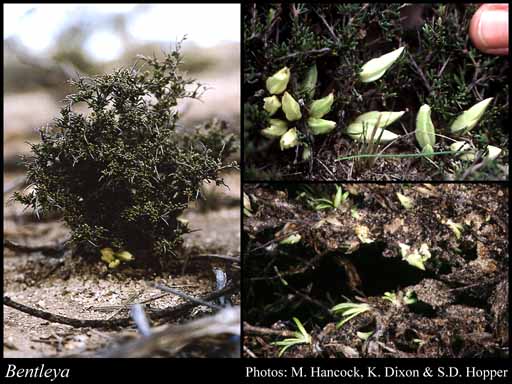- Reference
- Nuytsia 5(1):401 (1984)
- Name Status
- Current

Scientific Description
Family Pittosporaceae.
Habit and leaf form. Shrubs (with spreading rhizomes from which above-ground stems arise); evergreen. Plants unarmed, or spiny (younger branches ending in spines). To 0.05–0.2 m high. Mesophytic. Not heterophyllous. Leaves minute, or small; fasciculate (up to 7), or not fasciculate; alternate (or clustered); spiral; shortly petiolate, or sessile; simple. Leaf blades dorsiventral; entire (mucronate); linear, or ovate, or obovate (or spathulate). Mature leaf blades adaxially glabrous, or pubescent; abaxially pubescent. Leaf blade margins flat, or revolute.
Reproductive type, pollination. Fertile flowers hermaphrodite. Unisexual flowers absent. Plants hermaphrodite.
Inflorescence and flower features. Flowers solitary; terminal (or cauliflorous); pedicellate (with dense hairs); bracteate (subtended by 2 whorls of 5–6 bracts at the base of the pedicel); ebracteolate; small; regular; 5 merous; tetracyclic. Free hypanthium absent. Hypogynous disk present; intrastaminal; of separate members (5-lobed, fleshy, thick). Perianth with distinct calyx and corolla; 10; 2 -whorled; isomerous. Calyx present; 5; 1 -whorled; polysepalous; erect; hairy; exceeded by the corolla; green (or greenish-white). Sepals ovate. Corolla present; 5; 1 -whorled; gamopetalous (coherent at the base to form a more or less definite corolla tube); lobed (erect or incurved); imbricate; regular; hairy abaxially; hairy adaxially; plain; green. Androecium present. Androecial members definite in number. Androecium 5. Androecial members free of the perianth; free of one another. Stamens 5; becoming exserted, or remaining included; all more or less similar in shape; isomerous with the perianth; oppositisepalous; all alternating with the corolla members. Filaments glabrous. Anthers all alike; basifixed; versatile; dehiscing via longitudinal slits; tetrasporangiate. Fertile gynoecium present. Gynoecium 2 carpelled, or 3 carpelled. The pistil 2–3 celled. Gynoecium syncarpous; eu-syncarpous; superior. Ovary plurilocular; 2 locular, or 3 locular; shortly stipitate, or sessile. Ovary summit hairy, the hairs not confined to radiating bands. Gynoecium stylate. Styles 1; simple; hairy (pilose). Stigmas 1; 2 - lobed; capitate. Placentation parietal, or axile (by intrusion of the placentas). Ovules 30–50 per locule (i.e. ‘many’).
Fruit and seed features. Fruit hairy; dehiscent; a capsule. Capsules septicidal, or loculicidal (as well). Dispersal unit the seed. Seeds endospermic (well, developed and fleshy); laterally but not flat compressed (obliquely reniform in outline); wingless.
Geography, cytology, number of species. World distribution: Australia. Native of Australia. Endemic to Australia. Australian states and territories: Western Australia. South-West Botanical Province. A genus of 2 species; 2 species in Western Australia; 2 endemic to Western Australia.
Additional comments. Etymology: named to commemorate the students of Bently Technical College, particularly those in their final year in 1982.
Etymology. In commemoration of the students of Bentley Technical College Perth, Western Australia, particularly those in their final year in 1982, one of whom located this new genus.